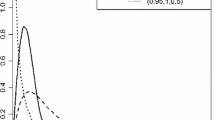Abstract
Proportional hazards frailty models use a random effect, so called frailty, to construct association for clustered failure time data. It is customary to assume that the random frailty follows a gamma distribution. In this paper, we propose a graphical method for assessing adequacy of the proportional hazards frailty models. In particular, we focus on the assessment of the gamma distribution assumption for the frailties. We calculate the average of the posterior expected frailties at several followup time points and compare it at these time points to 1, the known mean frailty. Large discrepancies indicate lack of fit. To aid in assessing the goodness of fit, we derive and estimate the standard error of the mean of the posterior expected frailties at each time point examined. We give an example to illustrate the proposed methodology and perform sensitivity analysis by simulations.
Similar content being viewed by others
References
O. O. Aalen, “Heterogeneity in Survival Analysis,”Statistics in Medicine vol. 7 pp. 1121–1137, 1988.
P. K. Andersen, O. Borgan, R. D. Gill, and N. Keiding,Statistical Models Based on Counting Processes Springer-Verlag: New York, 1993.
J. E. Anderson, T. A. Louis, and N. V. Holm, “Time Dependent Association for Bivariate Survival Distributions,”Journal of the American Statistical Association vol. 87 pp. 641–650, 1993.
S. M. Butler and T. A. Louis, “Random Effects Models with Non-Parametric Priors,”Statistics in Medicine vol. 11 pp. 1981–2000, 1993.
D. G. Clayton, “A Model for Association in Bivariate Life Tables and Its Application in Epidemiological Studies of Familial Tendency in Chronic Disease Incidence,”Biometrika vol. 65 pp. 141–151, 1978.
D. G. Clayton and J. Cuzick, “Multivariate Associations of the Proportional Hazards Model,”Journal of the Royal Statistical Society, Ser. A vol. 148 pp. 82–108, 1985.
D. G. Clayton. “A Monte-Carlo Methods for Bayesian Inference in Frailty Models,”Biometrics vol. 47 pp. 467–485, 1991.
D. R. Cox and D. V. Hinkley,Theoretical Statistics. Chapman and Hall: London, 1974.
A. P. Dempster, N. M. Laird, and D. B. Rubin, “Maximum Likelihood Estimation from Incomplete Data Via the EM Algorithm,”Journal of the Royal Statistical Society, Ser. B vol. 39 pp. 1–22, 1977.
GAUSS system Version 3.0, Kent, Washington: Aptech Systems, Inc., 1992.
T. Gordan and W. E. Kannel, “Introduction and General Background in the Framingham Study—The Framingham Study, Sections 1 and 2,” National Heart, Lung and Blood Institute, Bethesda, MD, 1968.
G. Guo and G. Rodriguez, “Estimating a Multivariate Proportional Hazards Model for Clustered Data Using the EM Algorithm, with an Application to Child Survival in Guatemala,”Journal of the American Statistical Association vol. 87 pp. 969–976, 1992.
J. J. Heckman and B. Singer, “A Method for Minimizing the Impact of Distributional Assumptions in Econometric Models for Duration Data,”Econometrica vol. 52 pp. 271–320, 1984.
P. Hougaard, “Survival Models for Heterogeneous Populations Derived from Stable Distributions,”Biometrika vol. 73 pp. 387–396, 1986.
P. Hougaard, “A Class of Multivariate Failure Time Distributions,”Biometrika vol. 73 pp. 671–678, 1986.
W. J. Huster, R. Brookmeyer, and S. G. Self, “Modeling Paired Survival Data with Covariates,”Biometrics vol. 45 pp. 145–156, 1989.
N. M. Laird, “Nonparametric Maximum Likelihood Estimation of a Mixing Distribution,”Journal of the American Statistical Association vol. 73 pp. 805–811, 1978.
N. M. Laird and T. A. Louis, “Smoothing the Non-Parametric Estimate of a Prior Distribution by Roughening: A Computational Study,” Computational Stat. and Data Analysis, vol. 12 pp. 27–37, 1991.
L. Lee, “Multivariate Distributions Having Weibull Properties,”Journal of Multivariate Analysis vol. 9 pp. 267–277, 1979.
D. Y. Lin, L. J. Wei, and Z. Ying, “Checking the Cox Model with Cumulative Sums of Martingale-Based Residuals,”Biometrika vol. 80 pp. 557–572, 1993.
K. G. Manton, E. Stallard, and J. W. Vaupel, “Alternative Models for the Heterogeneity of Mortality Risks Among the Aged,”Journal of the American Statistical Association vol. 81 pp. 635–644, 1986.
J. M. Neuhaus, W. W. Hauck, and J. D. Kalbfleisch, “The Effects of Mixture Distribution Misspecification when Fitting Mixed-Effects Logistic Models,”Biometrika vol. 79 pp. 755–762, 1992.
D. Oakes, “Bivariate Survival Models Induced by Frailties,”Journal of the American Statistical Association vol. 84 pp. 487–493, 1989.
D. A. Pierce, “The Asymptotic Effect of Substituting Estimators for Parameters in Certain Types of Statistics,”Annals of Statistics vol. 10 pp. 475–478, 1982.
B. D. Ripley,Stochastic Simulation. Wiley: New York, 1987.
J. H. Shih, and T. A. Louis, “Inferences on the Association Parameter in Copula Models for Bivariate Survival Data”,Biometrics, to appear.
L. J. Wei, D. Y. Lin, and L. Weissfeld, “Regression Analysis of Multivariate Incomplete Failure Time Data by Modeling Marginal Distributions,”Journal of the American Statistical Association vol. 84 pp. 1065–1073, 1989.
Author information
Authors and Affiliations
Rights and permissions
About this article
Cite this article
Shih, J.H., Louis, T.A. Assessing gamma frailty models for clustered failure time data. Lifetime Data Anal 1, 205–220 (1995). https://doi.org/10.1007/BF00985771
Received:
Accepted:
Issue Date:
DOI: https://doi.org/10.1007/BF00985771




